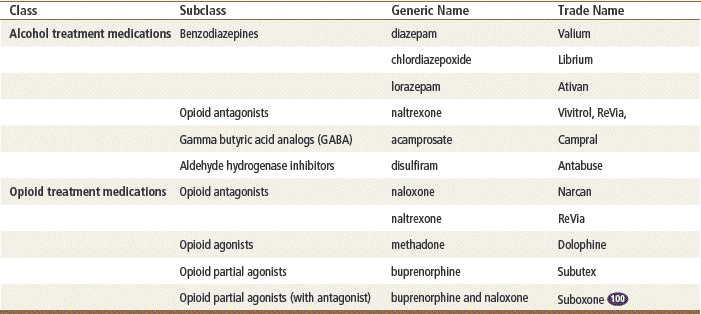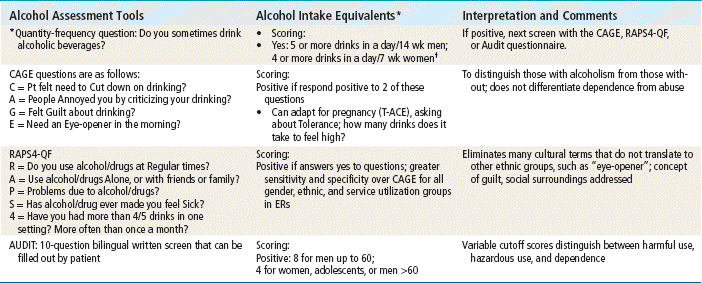http://evolve.elsevier.com/Edmunds/NP/

 Top 100 drug. Also consider using phenobarbital, carbamazepine, and topiramate, which are discussed in Chapter 45.
Top 100 drug. Also consider using phenobarbital, carbamazepine, and topiramate, which are discussed in Chapter 45.
This chapter discusses drugs used to treat abuse of alcohol and other drugs. A brief listing of pharmacologic treatments for opiate dependency is provided. In general, pharmacologic treatment can be especially helpful when used in conjunction with other treatment modalities for patients who are dependent on alcohol or opioids. Primary care often involves use of medications for the treatment of alcohol abuse. Treatment of opioid addiction is now within the scope of primary care by providers who receive additional approved training in the use of buprenorphine.
Therapeutic Overview
Alcohol and drug addictions are chronic bio-psycho-social-spiritual diseases that profoundly affect individuals, their families, and society in general. Alcohol dependence is a serious disease that causes approximately 100,000 deaths per year in the United States. Approximately 8 million people in the United States have an alcohol dependence problem. CDC data suggest that more than 38 million U.S. adults are binge drinkers, with 18- to 34-year-olds and seniors having the highest prevalence, drinking alcohol excessively an average of four times a month. Although not required for diagnosis, tolerance and withdrawal are frequently seen in substance use disorders. Tolerance is a central nervous system adaptation that occurs when a larger dose of alcohol or another drug of abuse is needed to obtain the desired effects. Withdrawal syndromes develop in alcohol- and drug-dependent individuals upon cessation or marked decrease. The physiologic effects of withdrawal symptoms are usually the opposite of those of the abused substance. Denial is seen invariably in individuals with substance use disorders.
Addiction to and misuse of prescription painkillers is a growing problem. A 2011 CDC report revealed that more than 40 people die each day due to overdoses of prescription painkillers such as Vicodin, methadone, Opana, and OxyContin. Deaths from painkiller overdoses have more than tripled in the past decade. The National Survey on Drug Use and Health found that 1 in 20 people aged 12 and older admitted using prescription painkillers for nonmedical reasons in 2010. Another study suggests that more than one in five children prescribed a controlled medication, such as Ritalin, take too much of it or misuse it. These children are more likely than others to abuse other substances and to start giving or selling drugs to their peers.
The U.S. Substance Abuse and Mental Health Services Administration reports a huge increase in the last 10 years in opiate admissions, mostly due to the use of prescription opioids. In response to the soaring demand, more community-based programs offering opioid overdose prevention services have become available in the United States, with the goal of more quickly reversing the potentially fatal respiratory depression caused by overdoses of heroin and other opioids, including prescription analgesics such as oxycodone, hydrocodone, and methadone.
Increasing numbers of newborns suffering drug withdrawal symptoms (or Neonatal Abstinence Syndrome) led the American Academy of Pediatrics to update treatment guidelines and call on hospitals to develop specific drug abuse screening protocols for mothers. Researchers report that in some area of the United States, up to 25% of NICU babies are treated for withdrawal, and the guidelines include how to best treat their pain during that time.
Assessment
All patients should be screened at least annually, both for extent of alcohol and drug use and any related problems. Alcoholics usually understate the amount of alcohol they consume. Addictions are largely the problem of people who begin the addictive behavior before the age of 21. However, individuals who continue to use illegal hard drugs from young adulthood into middle age face an increased risk of dying prematurely fivefold compared with those who do not use drugs.
It is important to assess for use of medications that interact adversely with alcohol, including H2-blockers, aspirin, benzodiazepines, antidepressants, narcotics, barbiturates, antihistamines, NSAIDs, metronidazole, sulfonamides, methyldopa, nitroglycerin, acetaminophen, isoniazid, antihypertensives, antidiabetic agents, warfarin, propranolol, and β-blockers. Also ask about profound drug–drug interactions that may result from alcohol-induced liver impairment and activation of CYP 2E1 metabolism.
Physical examination findings may include alcohol odor on the breath, flushed face, scleral injection, tremor, bruising, or peripheral neuropathy. Injuries from accidents such as falls may be evident. Frequently, people have severe alcohol disorders without apparent physical findings.
Laboratory tests should include CBC and LFTs. Macrocytosis is seen in more than 90% of patients (MCV 100-110 fL). This finding correlates with approximately 80 grams of alcohol consumption per day (e.g., one bottle of wine). The most sensitive laboratory tests for excessive chronic alcohol use included elevated AST and ALT, and especially GGT. When the ratio of AST to ALT becomes greater than 2, alcoholic hepatitis should be strongly suspected. A breath or blood alcohol level can also reveal the level of alcohol intake.
Classification Levels for Alcohol Intake
Alcohol Withdrawal
Mild symptoms include anxiety, decreased mental function, tremor, depression, and insomnia. Delirium tremens is an acute organic psychosis that occurs with mental confusion, tremor, sensory hyperacuity, visual hallucinations, autonomic hyperactivity, diaphoresis, tachycardia, or seizures. Withdrawal often occurs when a patient is removed from home to the hospital or nursing home. Seizures occur within the first 48 hours, more likely when alcohol dependence is present. Hallucinations (i.e., visual, auditory, or tactile misperceptions) commonly occur 12 to 72 hours after the last drink. DTs usually occur about 48-96 hours after the last drink.
Mechanism of Action and Effects of Alcohol Treatment
For alcohol withdrawal treatment, benzodiazepines demonstrate cross-tolerance with alcohol via GABA receptors. Long-acting benzodiazepines, such as diazepam or chlordiazepoxide, generally are preferred to minimize the occurrence of breakthrough agitation and seizures. Short-acting drugs such as lorazepam and oxazepam are used in patients with severe liver disease.
Naltrexone is an opioid antagonist with highest affinity for the mu opioid receptor. Occupation of opioid receptors by naltrexone may block the effects of endogenous opioid peptides. The neurobiologic mechanisms responsible for the reduction in alcohol consumption observed in alcohol-dependent patients treated with naltrexone are not entirely understood. However, involvement of the endogenous
TABLE 50-1
Screening and Assessment Tools for Alcohol Use Disorders

∗One standard drink = 12 ounces of beer, 5 ounces of wine, or 1.5 ounces of 80-proof spirits.
†May be excessive if >65 years, with medical problems. If pregnant, advise abstinence.
Adapted from Helping patients who drink too much, a clinician’s guide, publication No. 05-3769, 2005, NIAA, NIH.
opioid system probably has its effect on alcohol consumption. Naltrexone has some effect on cravings for alcohol. It does not cause the physical adverse effects that are produced by disulfiram. Naltrexone blocks opiate receptors that are involved in the rewarding effects of drinking alcohol and the cravings after abstinence is established.
Acamprosate is structurally related to GABA agonists and potentiates the inhibitory effects of the GABAergic system. Patients with alcohol dependence notably display an imbalance of GABA and glutamate neuronal transmission, which may be restored by acamprosate. This agent decreases glutamatergic transmission and modulates neuronal hyperexcitability during withdrawal from alcohol. It reduces voluntary intake of alcohol but does not cause a disulfiram-like reaction. Acamprosate is possibly helpful with regenerating neurotransmitters and restoring the balance between GABA and glutamate when alcohol intake has stopped or has been significantly decreased.
Disulfiram, a potent alcohol dehydrogenase inhibitor, blocks the oxidation of alcohol at the acetaldehyde stage by inhibiting the enzyme aldehyde dehydrogenase. With alcohol ingestion, disulfiram causes the patient to feel extremely unpleasant sensations ranging from flushing, dyspnea, and tachycardia to confusion, vomiting, and syncope. Unpleasant symptoms can last from 30 minutes to 2 hours, and the intensity of the reaction depends on the amount of alcohol ingested, the dose of disulfiram taken, and the time that has elapsed between the two. The theory behind disulfiram use in the treatment of alcoholism is based on aversion. Acute reactions may be fatal.
Topiramate is a seizure medication that can help curb the craving for alcohol. This drug acts by reducing excess dopamine released through alcohol consumption. Researchers have found that patients given this drug were six times more likely than those taking a placebo to abstain from alcohol for a month.
Buprenorphine exerts its analgesic effect via high affinity binding to opiate receptors in the CNS; it displays partial mu agonist and weak kappa antagonist activity.
Treatment Principles
Stay updated, free articles. Join our Telegram channel

Full access? Get Clinical Tree


